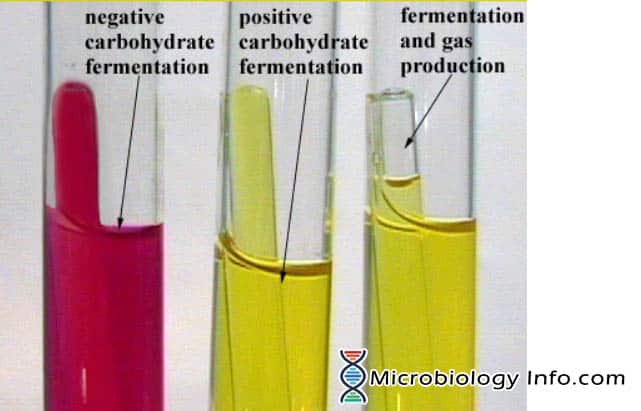- Fermentation media are used to differentiate organisms based on their ability to ferment carbohydrates incorporated into the basal medium.
- Phenol Red Broth Medium with various added carbohydrates serves as a differential medium by aiding in differentiation of various species and genera by their ability to ferment the specific carbohydrate, with the production of acid or acid and gas.
- The carbohydrate source can vary based on test requirements. The common broth media used are:
- Phenol Red Glucose Broth
- Phenol Red Lactose Broth
- Phenol Red Maltose Broth
- Phenol Red Mannitol Broth
- Phenol Red Sucrose Broth
Objective
To determine the fermentation reactions of pure cultures of microorganisms.
Principle
Carbohydrate fermentation is the process microorganisms use to produce energy. Most microorganisms convert glucose to pyruvate during glycolysis; however, some organisms use alternate pathways. A fermentation medium consists of a basal medium containing a single carbohydrate (glucose, lactose, sucrose, mannitol etc.) for fermentation. However, the medium may contain various color indicators. In addition to a color indicator to detect the production of acid from fermentation, a Durham tube is placed in each tube to capture gas produced by metabolism. The carbohydrate fermentation patterns shown by different organisms are useful in differentiating among bacterial groups or species.
Media
Phenol Red Broth is a general-purpose differential test medium typically used to differentiate gram negative enteric bacteria. It contains peptone, phenol red (a pH indicator), a Durham tube, and one carbohydrate (glucose, lactose, or sucrose). Phenol red is a pH indicator which turns yellow below a pH of 6.8 and fuchsia above a pH of 7.4. If the organism is able to utilize the carbohydrate, an acid by-product is created, which turns the media yellow. If the organism is unable to utilize the carbohydrate but does use the peptone, the by-product is ammonia, which raises the pH of the media and turns it fuchsia. When the organism is able to use the carbohydrate, a gas by-product may be produced. If it is, an air bubble will be trapped inside the Durham tube. If the organism is unable to utilize the carbohydrate, gas will not be produced, and no air bubble will be formed.
Method
- Aseptically inoculate each test tube with the test microorganism using an inoculating needle or loop. Alternatively, inoculate each test tube with 1-2 drops of an 18- to 24-hour brain-heart infusion broth culture of the desired organism.
- Incubate tubes at 35-37°C for 18-24 hours.
- Check for color changes or formation of gas.
Result Interpretation
I. Acid production:
- Positive: After incubation the liquid in the tube turns yellow (indicated by the change in the color of the phenol red indicator). It indicates that there is drop in the pH because of the production of the acid by the fermentation of the carbohydrate (sugar) present in the media.
- Negative:The tube containing medium will remain red, indicating the bacteria cannot ferment that particular carbohydrate source present in the media.
II. Gas Production
- Positive:A bubble (small or big depending up the amount of gas produced) seen in the inverted Durham tube.
- Negative: No bubble in the inverted Durham tube i.e. bacteria does not produce gas from the fermentation of that particular carbohydrate present in the media i.e. anaerogenic organism.

Uses
- It is recommended to determine the fermentation reaction of carbohydrates for the differentiation of microorganisms.
- It is useful in identifying Gram negative bacilli, especially Enterobacteriaceae.
Limitations
- Phenol Red Broth test is not intended for use in the diagnosis of disease or other conditions in humans.
- Due to nutritional variation, some strains may be encountered that grow poorly or fail to grow on this medium.
- The addition of some carbohydrates to the basal medium may result in an acid reaction. To ensure accuracy of interpretation, uninoculated control tubes and/or inoculated Phenol Red Broth Base control tubes should be run in parallel with the fermentation tests.
Reference
- https://homepages.wmich.edu/~rossbach/bios312/LabProcedures/Biochem%20characteristics%20procedures.html
- www.himedialabs.com/TD/M054.pdf
- www.austincc.edu/microbugz/phenol_red_broth.php
- https://quizlet.com/56724336/phenol-red-broth-flash-cards/
- foodsafety.neogen.com/pdf/acumedia_pi/7148_pi.pdf
- spot.pcc.edu/~jvolpe/b/bi234/lab/differentialMedia/CarboFermentationTest2.html
